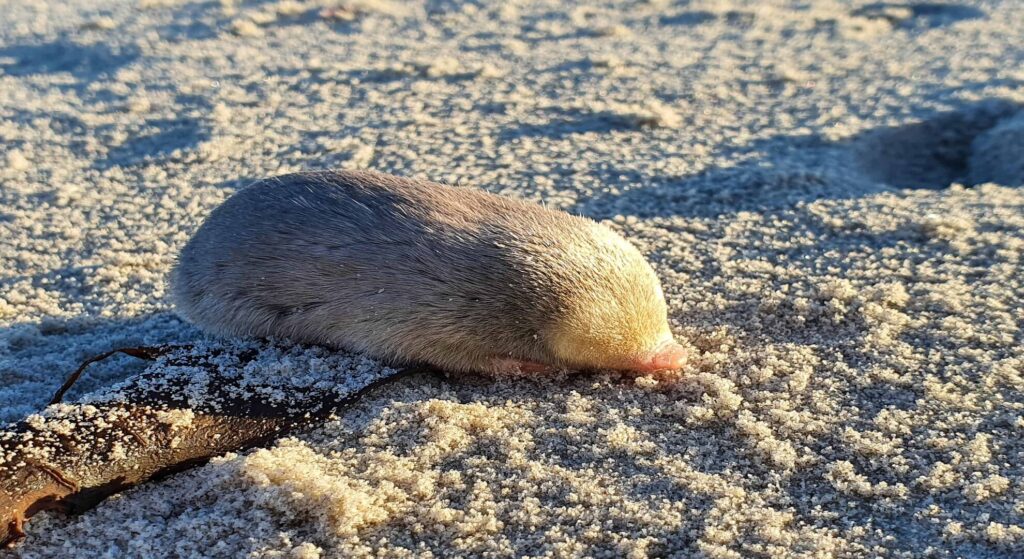After not having seen them for more than eight decades (as researchers presumed them to be extinct), a species of a mode with an elusive, iridescent coat was rediscovered “swimming” through in the sand dunes of South Africa, researchers announced.
The De Winton’s golden mole (Cryptochloris wintoni), previously believed to be extinct as it has been lost since before the Second World War, is found to be still alive on a beach in Port Nolloth on the west coast of South Africa by a group of researchers from the Endangered Wildlife Trust (EWT) and the University of the Pretoria (UP). The last time it was documented was in 1937, also in the mentioned area of the country.
These species are said to be living in underground, inaccessible burrows. It is called “golden” due to its oily secretions that lubricate its fur, enabling it to “swim” through sand dunes. This also means that it does not produce conventional tunnels, resulting in its tough, painstaking detection.
It is also blind, heavily relies on its “super-hearing powers”, and would quickly maneuver if it senses any vibrations caused by above-ground movements. In addition, it eats insects to live. The animal has been included among the “most wanted” list of lost species compiled by Re:wild, a global conservation group.
With the assistance of a trained sniffer dog named Jessie, a border collie, the conservationists spent a two-year search, gathering evidence for the elusive mole by collecting at least 100 soil samples from various sites up to 18km (11.2 miles) of dunes per day and analyzing them for environmental DNA (eDNA). This DNA is from skin cells, hair, and bodily excretions the golden mole leaves behind as they move through the dunes.
Eventually, the team encountered fresh traces of golden mole burrows and tunnels that had been revealed by recent heavy rains.
According to the researchers, Jessie the dog lies down to mark the spot where she detected the scent, which identified two common species of golden mole, namely cape golden mole (Chrysochloris asiatica) and Grant’s golden mole (Eremitalpa granti). On the contrary, the dog was unresponsive to the Port Nolloth field signs, suggesting that the tracks had not been produced by one of the usual species, raising hopes they were evidence of De Winton’s golden mole.
Besides the two common golden mole species, analysis of eDNA from all the gathered samples revealed the rare, endangered Van Zyl’s golden mole (Cryptochloris zyli) and it determined a species closely related to Van Zyl’s golden mole. The team thought this could be the lost De Winton’s golden mole but they were unable to confirm it until the samples were genetically sequenced as the said species looked similar to other golden moles.
The researchers had to wait until 2022 when a decades-old DNA sample from a De Winton’s golden mole specimen stored at a Cape Town museum became available for study. After examining and comparing the gene sequence of both samples, the researchers officially confirmed that the fourth species was truly the De Winton’s golden mole.
“Though many people doubted that De Winton’s golden mole was still out there, I had good faith that the species had not yet gone extinct,” said EWT’s senior conservation manager and search team member Cobus Theron. “I was convinced it would just take the right detection method, the proper timing, and a team passionate about finding it.”
“Now, not only have we solved the riddle, but we have tapped into this eDNA frontier where there is a huge amount of opportunity – not only for moles but for other lost or imperilled species,” he continued.
During their research beginning in 2021, four more populations of De Winton’s golden mole have been located. Coinciding with the researchers, they believe the Port Nolloth is home to a healthy population of the species. Although this is the case, the area is vulnerable and is threatened by diamond mining right now.
“We need to identify areas to focus our conservation [efforts] on … and secure protected areas to make sure there are still strongholds for these species,” told JP Le Roux, former EWT field officer.
Currently, the researchers’ findings have been peer-reviewed and published in the journal Biodiversity and Conversation on November 24.
The mentioned golden mole is listed in Re:wild’s Search for Lost Species Project launched in 2017. Its primary aim is to search and rediscover 25 animal, plant, and fungi species that have been believed to be lost to science for more than 10 years or longer but are not yet formally classified as extinct by the IUCN Red List of Threatened Species.
At present, 11 of the lost species have been found, including Attenborough’s long-beaked echidna (Zaglossus attenboroughi), Wallace’s giant bee (Megachile pluto), considered to be the largest bee on the planet as well as the velvet pitcher plant (Nepenthes mollis), which had been regarded as lost for over 100 years before its rediscovery.
Other POP! stories that you might like:
‘My loneliness is killing me’: Loneliness is as harmful as smoking 15 cigarettes a day, says study
Rare ‘Red Aurora’ surprises and amazes Mongolians
‘Dinagdagan kasi ginalingan’: How ‘performance punishment’ affects workers and employees
Recent Family Feud PH episode proves that some are still falling behind in gender sensitivity



